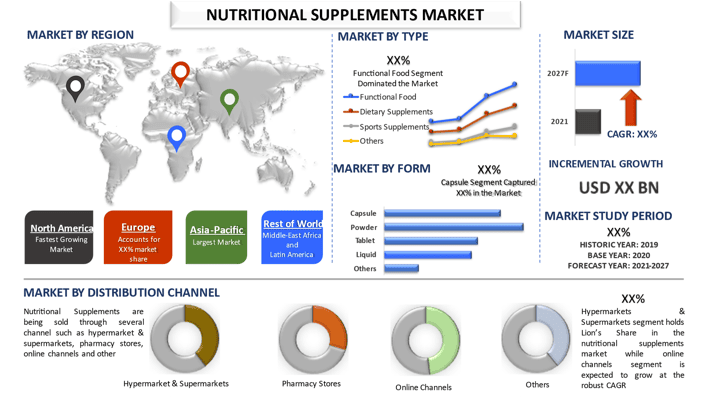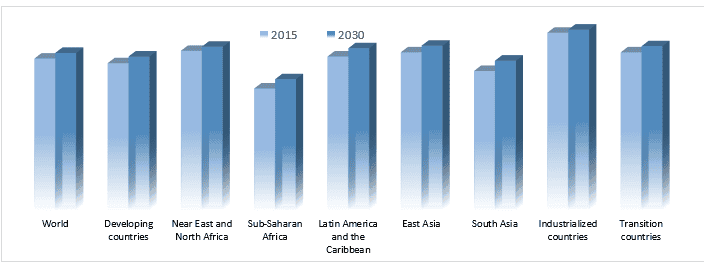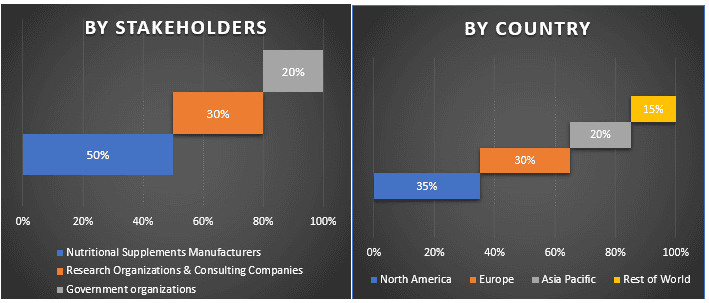- Home
- About Us
- Industry
- Services
- Reading
- Contact Us
Nutritional Supplements Market: Current Analysis and Forecast (2021-2027)
Emphasis on Product Type (Dietary Supplements, Sports Supplements, Functional, Food, Others); Ingredients (Vitamin, Protein, Consumer Group (Infants, Children, Adults, Pregnant, Geriatric); Distribution Channels (Supermarkets & Hypermarkets, Pharmacy Stores, Online Channel, Other); Region/Country

The Global Nutritional Supplements is Expected to Display an Elevated CAGR of ~7% over the forecast period (2021-2027)
The key factors attributed to the growth of the nutritional supplements market across the globe are growth in the demand for fortified food owing to the increasing health consciousness amongst consumers, availability of nutritional supplements as per consumer need, etc., As per the U.S department of agriculture, the spending on food by the countries such as the United States, United Kingdom, Canada, and South Korea was registered around 2595, 1951, 2294 and 1501 respectively in 2020, which increased from 2478, 2295, 2239 and 1675 in 2015. Also, emerging incidences of chronic diseases such as Cancer, Cardiovascular Disease, and type 2 diabetes worldwide and guidelines on nutritional intake by government organizations are acting as the growth catalyst to the industry. As per the International Agency for Research on Cancer (IARC), 1 in 5 people develop cancer during their lifetime globally and 1 in 11 women die from cancer. The rising prevalence of diseases is emerging as the demand for nutritional supplements.
Moreover, rising consumer awareness about the nutrient insufficiency due to improper food consumption, an emerging number of malnutrition suffered people, etc is acting as agrowth catalyst to the industry. As per a study by Oregon State University, About 75% of the US population (ages ≥1 year) do not consume the recommended intake of fruit, and more than 80% do not consume the recommended intake of vegetables. In addition, nearly 10% of the U.S. population has nutrition deficiencies. 10.5% population has Vitamin B6 deficiency, while 8.1% have vitamin D deficiency, as revealed by the Centers for Disease Control and Prevention
Average Annual Expenditure on Furniture Per Consumer Unit in the United States (2011-20)
Amway, Abbott Nutrition, Nestle, Archer Daniels Midland (ADM), American Health, DSM, Arko pharma Laboratories Pharmaceutiques, DuPont, Herbalife International of America, Inc, Glanbia plc., etc. are some of the prominent players operating in the Nutritional Supplements market. Several M&As along with partnerships have been undertaken by these players to facilitate customers with hi-tech and innovative products.
Insights Presented in the Report
“Amongst Product Type, Functional Food segment holds the major share”
Based on the product type, the market is fragmented into Dietary Supplements, Sports Supplements, Functional Food, and Others. The functional food segment grabbed the major market share and dominated the market. The segment captured XX% market share in 2020. The segment is witnessing an uptick owing to the benefit such as functional foods ingredients offer a health benefit beyond basic nutrition for the improvement of outer or inner health.
“Amongst Ingredients, Fatty acids segment to grab considerable market share”
Based on ingredients, the market is fragmented into vitamins, protein, fatty acids, botanicals, minerals, and others. The fatty acids segment grabbed the XX% market share in 2020. The increasing prevalence of chronic diseases is augmenting the consumer shift towards healthier food alternatives including Omega 3. As per the Food and Agriculture Organization, by 2020, chronic diseases will account for almost three-quarters of all deaths worldwide, and that 75% of deaths are due to stroke, 71% of deaths due to ischaemic heart disease (IHD), and 70% of deaths due to diabetes will occur in developing countries
“Amongst Form Type, Powder segment holds the major share”
Based on form, the market is fragmented into Capsule, Powder, Tablet, Liquid, and Others. The powder segment grabbed the XX% market share in 2020. Growing consumption of protein powders, green tea, vitamin supplement powders is driving the growth of this segment. However, the liquid segment would witness a robust CAGR in the forthcoming years.
“Amongst Consumer Group, Adults segment holds the major share”
Based on the consumer group, the market is fragmented into Infants, Children, Adults, Pregnant and Geriatric. The adults’ segment grabbed the major market share and dominated the market. The segment captured XX% market share in 2020. The rise in awareness of health and fitness, growing participation in fitness activities, and growing disposable income is driving the segment growth.
“Amongst Distribution Channel, Hypermarkets & Supermarkets segment holds the major share”
Based on the distribution channel, the market is fragmented into Supermarkets & Hypermarkets, Pharmacy Stores, Online Channels, and Others. The supermarkets and hypermarkets segment grabbed the major market share and dominated the market. The key factors attributed to the growing share of the segment is the availability of numerous brands under one roof, expanding supermarkets and hypermarket chains, etc.,
“Asia-Pacific represents one of the largest markets of Nutritional Supplements market”
For a better understanding of the market dynamics of the Nutritional Supplements market, a detailed analysis was conducted for different regions across the globe including North America, Europe, Asia Pacific, and the Rest of the world. The Asia Pacific dominated the market and generated the leading revenue share in 2020 owing to the availability of Nutritional Supplements manufacturers in abundance and new launches are some of the factors that are contributing to the growth of the market.
Reasons to buy this report:
- The study includes market sizing and forecasting analysis validated by authenticated key industry experts
- The report presents a quick review of overall industry performance at one glance
- The report covers an in-depth analysis of prominent industry peers with a primary focus on key business financials, product portfolio, expansion strategies, and recent developments
- Detailed examination of drivers, restraints, key trends, and opportunities prevailing in the industry
- The study comprehensively covers the market across different segments
- Deep dive regional level analysis of the industry
Customization Options:
The Nutritional Supplements Market can further be customized as per the requirement or any other market segment. Besides this, UMI understands that you may have your own business needs, hence feel free to connect with us to get a report that completely suits your requirements.
Table of Content
Analyzing the historical market, estimation of the current market, and forecasting the future market of the Nutritional Supplements Market were the three major steps undertaken to create and analyze the demand for Nutritional Supplements across major regions. Exhaustive secondary research was conducted to collect the historical market numbers and estimate the current market size. Secondly, to validate these insights, numerous findings and assumptions were taken into consideration. Moreover, exhaustive primary interviews were also conducted, with industry experts across the value chain of the Nutritional Supplements market. Post assumption and validation of market numbers through primary interviews, we employed a top-down/ bottom-up approach to forecast the complete market size. Thereafter, market breakdown and data triangulation methods were adopted to estimate and analyze the market size of segments and sub-segments the industry pertains to. Detailed methodology is explained below:
Analysis of Historical Market Size
Step 1: In-Depth Study of Secondary Sources:
Detailed secondary study was conducted to obtain the historical market size of the Nutritional Supplements through company internal sources such as annual reports & financial statements, performance presentations, press releases, etc., and external sources including journals, news & articles, government publications, competitor publications, sector reports, third-party database, and other credible publications.
Step 2: Market Segmentation:
After obtaining the historical market size of the Nutritional Supplements market, we conducted a detailed secondary analysis to gather historical market insights and share for type, end-user, and distribution channel for major regions. Major segments included in the report are product type, ingredients, form, and consumer group. Further region and country-level analyses were conducted to evaluate the overall adoption of Nutritional Supplements across the globe.
Step 3: Factor Analysis:
After acquiring the historical market size of different segments and sub-segments, we conducted a detailed factor analysis to estimate the current market size of the Nutritional Supplements. Further, we conducted factor analysis using dependent and independent variables such as the rise in disposable income, surging awareness, etc., A thorough analysis was conducted for demand and supply-side scenarios considering top partnerships, merger and acquisition, business expansion, and product launches in the Nutritional Supplements industry across the globe.
Current Market Size Estimate & Forecast
Current Market Sizing: Based on actionable insights from the above 3 steps, we arrived at the current market size, key players in the Nutritional Supplements market, and market shares of the segments. All the required percentage shares split, and market breakdowns were determined using the above-mentioned secondary approach and were verified through primary interviews.
Estimation & Forecasting: For market estimation and forecast, weightage was assigned to different factors including drivers & trends, restraints, and opportunities available for the stakeholders. After analyzing these factors, relevant forecasting techniques i.e. bottom-up/ top-down approach was applied to arrive at the market forecast about 2027 for different segments and subsegments across the major markets globally. The research methodology adopted to estimate the market size encompasses:
- The industry’s market size, in terms of value (US$) and the adoption rate of Nutritional Supplements across the major markets domestically
- All percentage shares, splits, and breakdowns of market segments and sub-segments
- Key players in the Nutritional Supplements market in terms of services offered. Also, the growth strategies adopted by these players to compete in the fast-growing market
Market Size and Share Validation
Primary Research: In-depth interviews were conducted with the Key Opinion Leaders (KOLs) including Top Level Executives (CXO/VPs, Sales Head, Marketing Head, Operational Head, and Regional Head, Country Head, etc.) across major regions. Primary research findings were then summarized, and statistical analysis was performed to prove the stated hypothesis. Inputs from primary research were consolidated with secondary findings, hence turning information into actionable insights.
Split of Primary Participants in Different Regions
Market Engineering
Data triangulation technique was employed to complete the overall market estimation and to arrive at precise statistical numbers of each segment and sub-segment of the Nutritional Supplements market. Data was split into several segments sub-segments post studying various parameters and trends in the areas of product type, ingredients, form, and consumer group of the Nutritional Supplements market.
Main Objective of the Nutritional Supplements Market Study
The current & future market trends of Nutritional Supplements were pinpointed in the study. Investors can gain strategic insights to base their discretion for investments from the qualitative and quantitative analysis performed in the study. Current and future market trends were determined the overall attractiveness of the market at a regional level, providing a platform for the industrial participant to exploit the untapped market to benefit as a first-mover advantage. Other quantitative goals of the studies include:
- Analyze the current and forecast market size of Nutritional Supplements in terms of value (US$). Also, analyze the current and forecast market size of different segments and sub-segments
- Segments in the study include areas of product type, ingredients, form, and consumer group
- Define and analysis of the regulatory framework for the Nutritional Supplements industry
- Analyze the value chain involved with the presence of various intermediaries, along with analyzing customer and competitor behaviors of the industry
- Analyze the current and forecast market size of the Nutritional Supplements market for the major countries
- The major region studied in the report includes North America, Europe, Asia- Pacific, and the Rest of the World.
- Company profiles of the Nutritional Supplements market and the growth strategies adopted by the market players to sustain in the fast-growing market
Deep dive regional level analysis of the industry
Related Reports
Customers who bought this item also bought










